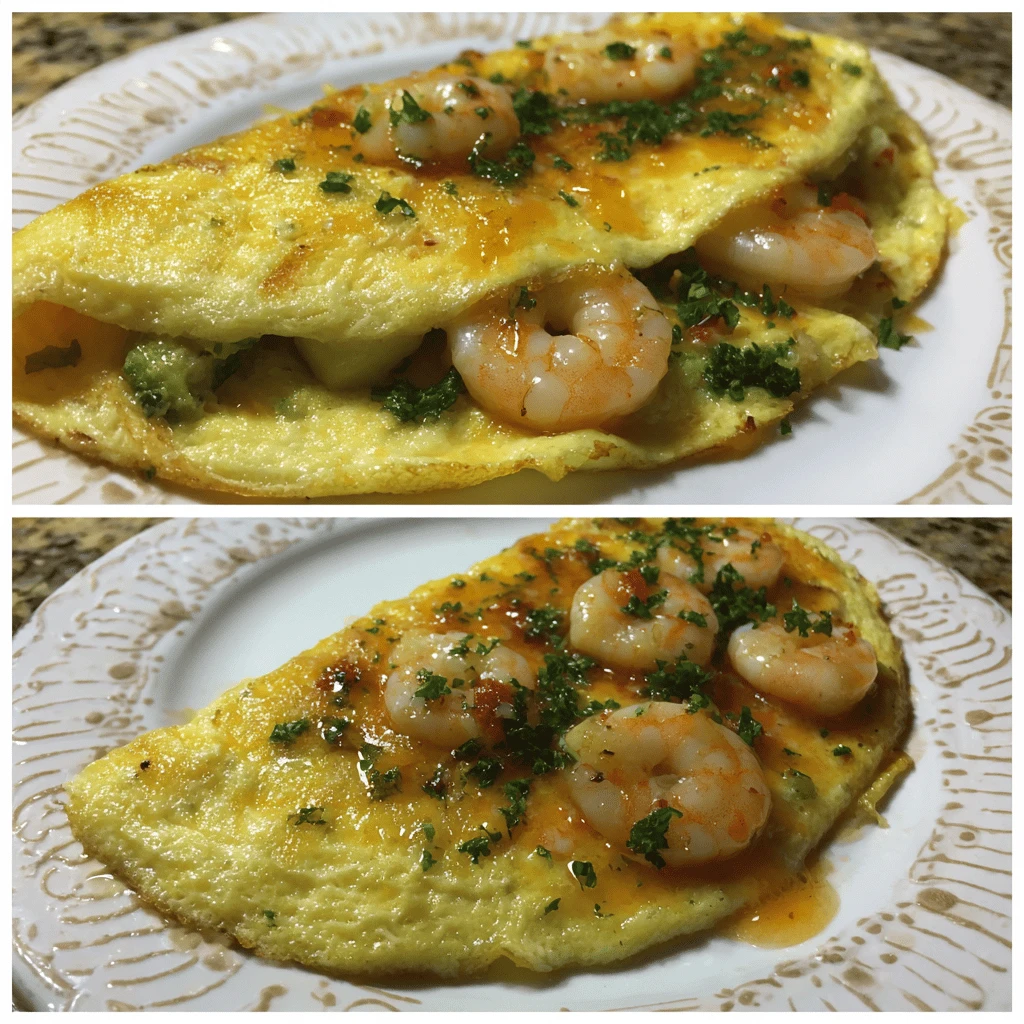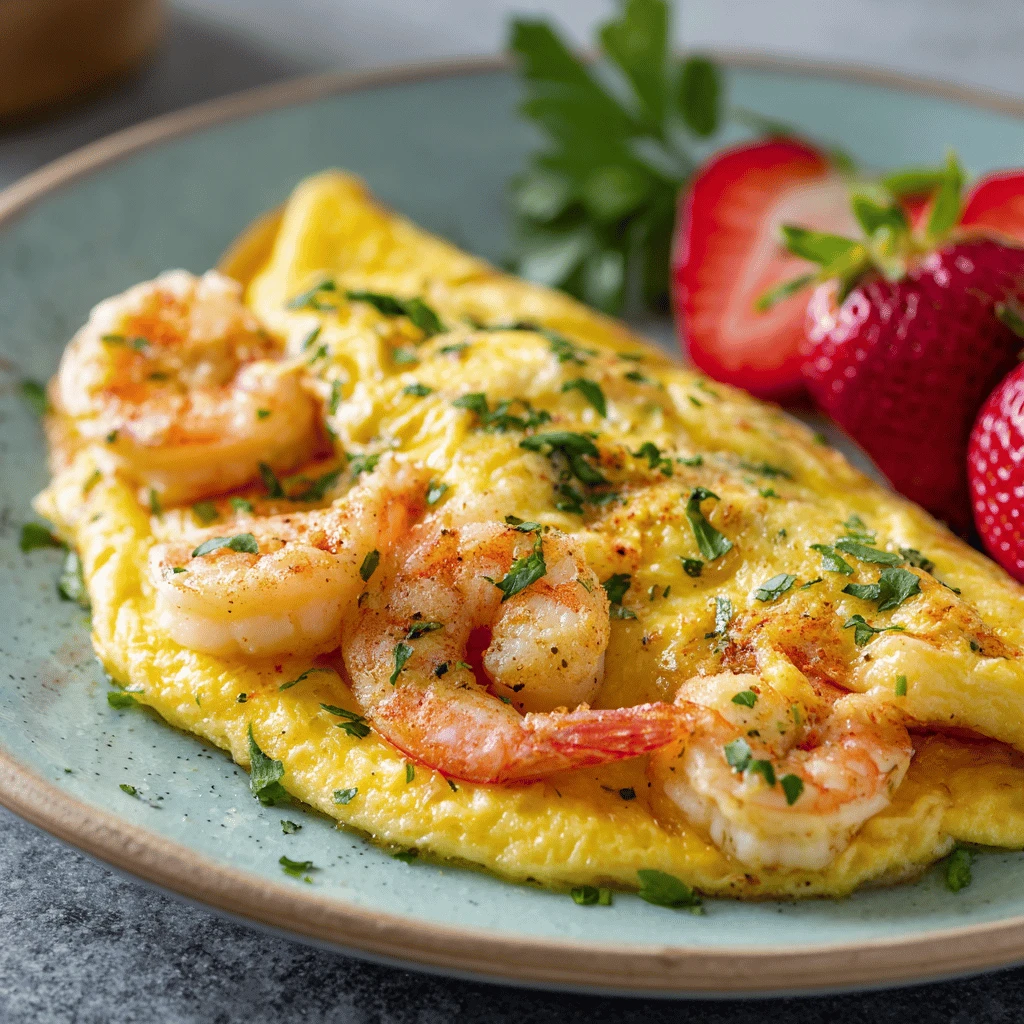Easy Low Carb Shrimp Omelette
Introduction: A Delicious and Healthy Start to Your Day
Looking for a quick, satisfying, and healthy breakfast that fits your low-carb lifestyle? Look no further than the easy low-carb shrimp omelette! This versatile dish is packed with protein, healthy fats, and delicious flavor, making it the perfect way to start your day or enjoy a light lunch or dinner. Omelettes are incredibly customizable, and adding shrimp elevates them from a simple egg dish to a gourmet meal. This recipe is not only delicious but also takes minimal time and effort to prepare, making it ideal for busy mornings or weeknight meals.
Section 1: Why Shrimp and Omelettes Are a Perfect Match
Nutritional Benefits of Shrimp
Shrimp is a nutritional powerhouse! It’s low in calories and carbohydrates, making it an excellent choice for low-carb diets like keto. It’s also rich in protein, which is essential for building and repairing tissues. Shrimp also contains selenium, iodine, and vitamin B12, all of which are vital for overall health. The omega-3 fatty acids found in shrimp contribute to heart health and brain function. When combined with eggs, the nutritional value of your omelette skyrockets.
Why Omelettes Are Great for Low-Carb Diets
Omelettes are a naturally low-carb option. Eggs are primarily protein and healthy fats, with minimal carbohydrates. This makes them a staple in many low-carb diets, including keto and Atkins. You can easily customize your omelette with low-carb vegetables and cheeses to create a filling and nutritious meal. Adding shrimp further boosts the protein content, keeping you feeling full and satisfied for longer. Furthermore, omelettes are incredibly versatile, allowing you to experiment with different flavors and ingredients.
Flavor Profile: The Delicious Combination of Shrimp and Eggs
The delicate sweetness of shrimp pairs beautifully with the savory richness of eggs. Whether you use fresh or frozen shrimp, its subtle flavor complements the creamy texture of the omelette. You can enhance the taste further by adding herbs, spices, and cheeses that complement both shrimp and eggs, such as garlic, paprika, chives, and cheddar cheese. This combination creates a delightful flavor profile that is both satisfying and exciting.
Section 2: Assembling Your Low-Carb Shrimp Omelette: Ingredients and Preparation
Essential Ingredients
- Eggs: 2-3 large eggs per omelette are ideal. Opt for free-range or organic eggs if possible for better quality and taste.
- Shrimp: 1/4 cup cooked shrimp per omelette. Use pre-cooked shrimp to save time, or quickly sauté raw shrimp in a pan with a little garlic and oil. Smaller shrimp are often easier to distribute evenly throughout the omelette.
- Butter or Olive Oil: 1 tablespoon for cooking. Butter adds a richer flavor, while olive oil is a healthier option.
- Cheese (Optional): 1/4 cup shredded cheddar, mozzarella, or Monterey Jack cheese. Choose your favorite low-carb cheese for added flavor and creaminess.
- Vegetables (Optional): 1/4 cup diced onions, bell peppers, spinach, mushrooms, or other low-carb vegetables. These add nutrients and texture to your omelette. Sauté the vegetables briefly before adding them to the omelette.
- Seasoning: Salt, pepper, garlic powder, paprika, or any other herbs and spices you enjoy.
Step-by-Step Preparation Guide
1. Prepare the Shrimp: If using raw shrimp, sauté it in a pan with a little garlic and oil until pink and cooked through. If using pre-cooked shrimp, simply chop it into smaller pieces.
2. Whisk the Eggs: In a bowl, whisk together the eggs with a splash of water or cream for added fluffiness. Season with salt, pepper, and any other desired spices.
3. Cook the Omelette: Heat butter or olive oil in a non-stick skillet over medium heat. Pour the egg mixture into the skillet and let it cook for a minute or two until the edges begin to set.
4. Add the Fillings: Sprinkle the cooked shrimp, cheese, and any other desired vegetables over one half of the omelette.
5. Fold and Finish: Using a spatula, gently fold the other half of the omelette over the fillings. Cook for another minute or two until the cheese is melted and the omelette is cooked through.
6. Serve: Slide the omelette onto a plate and serve immediately. Garnish with fresh herbs like chives or parsley, if desired.
Tips for Perfect Omelettes Every Time
- Use a Non-Stick Skillet: This is crucial for preventing the omelette from sticking and tearing.
- Don’t Overcook the Eggs: Overcooked eggs become dry and rubbery. Cook the omelette until it is just set but still slightly moist.
- Pre-Cook Vegetables: Raw vegetables can release moisture and make the omelette soggy. Sauté them briefly before adding them to the omelette.
- Don’t Overfill the Omelette: Too many fillings can make it difficult to fold the omelette and can cause it to break apart.
- Use Medium Heat: Cooking over high heat can cause the omelette to cook too quickly and burn on the outside while remaining uncooked on the inside.
Section 3: Variations and Customizations: Making It Your Own
Different Shrimp Preparations
- Garlic Butter Shrimp: Sauté the shrimp in garlic butter for an extra rich and flavorful filling.
- Spicy Shrimp: Add a pinch of red pepper flakes or a dash of hot sauce to the shrimp for a spicy kick.
- Lemon Herb Shrimp: Marinate the shrimp in lemon juice, olive oil, and herbs before cooking.
- Blackened Shrimp: Season the shrimp with blackened seasoning for a smoky and savory flavor.
Exploring Low-Carb Vegetable Combinations
- Spinach and Feta Omelette: A classic combination that is both healthy and delicious.
- Mushroom and Swiss Omelette: Earthy mushrooms and nutty Swiss cheese create a sophisticated flavor profile.
- Bell Pepper and Onion Omelette: A simple yet satisfying combination that adds color and crunch to your omelette.
- Asparagus and Parmesan Omelette: A springtime favorite that is light and refreshing.
Cheese Options for Added Flavor and Texture
- Cheddar Cheese: A classic choice that adds a sharp and tangy flavor.
- Mozzarella Cheese: A mild and creamy cheese that melts beautifully.
- Monterey Jack Cheese: A mild and slightly sweet cheese that pairs well with shrimp.
- Feta Cheese: A salty and tangy cheese that adds a Mediterranean flair.
- Cream Cheese: Adds a very creamy texture.
Adding Herbs and Spices for Enhanced Taste
- Chives: A mild onion flavor that adds a fresh and vibrant touch.
- Parsley: A versatile herb that adds a fresh and clean flavor.
- Dill: A slightly sweet and herbaceous flavor that pairs well with seafood.
- Garlic Powder: Adds a savory and aromatic flavor.
- Paprika: Adds a smoky and slightly sweet flavor.
- Cayenne Pepper: Adds a spicy kick.
Section 4: Serving Suggestions and Pairings
Complementary Side Dishes
- Avocado Slices: Provide healthy fats and a creamy texture.
- Side Salad: A light and refreshing salad with a vinaigrette dressing.
- Steamed Vegetables: Broccoli, asparagus, or spinach are excellent low-carb choices.
- Cauliflower Rice: A low-carb alternative to traditional rice.
- Berries: A small portion of berries can add a touch of sweetness and antioxidants.
Drink Pairings to Enhance the Meal
- Black Coffee: A classic pairing for breakfast that provides energy and complements the savory flavors of the omelette.
- Unsweetened Tea: A refreshing and hydrating option that pairs well with the light flavors of the omelette.
- Sparkling Water with Lemon: A bubbly and refreshing drink that cleanses the palate.
- Bone Broth: A nourishing and savory option that provides additional protein and nutrients.
Plating and Presentation Tips
- Garnish with Fresh Herbs: A sprinkle of fresh chives or parsley adds a pop of color and freshness.
- Serve on a Warm Plate: This helps to keep the omelette warm for longer.
- Arrange the Side Dishes Artistically: Create a visually appealing plate by arranging the side dishes in a thoughtful manner.
- Add a Drizzle of Olive Oil: A drizzle of extra virgin olive oil adds flavor and shine.
Section 5: Common Questions and Troubleshooting
FAQs About Low-Carb Shrimp Omelettes
- Can I use frozen shrimp? Yes, you can definitely use frozen shrimp. Just make sure to thaw it completely before cooking. Patting it dry will also help it brown better.
- What kind of cheese is best for a low-carb omelette? Cheddar, mozzarella, Monterey Jack, and feta are all great low-carb options. Choose your favorite or experiment with different combinations.
- How can I make my omelette fluffier? Whisk the eggs thoroughly and add a splash of water or cream to the mixture. Don’t overcook the eggs, as this can make them tough.
- Can I add cream cheese to my omelette? Yes, adding a small amount of cream cheese can add a creamy texture and a tangy flavor.
- What other fillings can I add to my low-carb omelette? The possibilities are endless! Consider adding vegetables like spinach, mushrooms, onions, and bell peppers. You can also add cooked meats like sausage or bacon.
- Is shrimp keto-friendly? Yes, shrimp is very keto-friendly. It is low in carbohydrates and high in protein.
- How do I prevent my omelette from sticking to the pan? Use a non-stick skillet and make sure to heat the pan properly before adding the egg mixture. Use enough butter or oil to coat the bottom of the pan.
- How long does a shrimp omelette last in the fridge? Leftover shrimp omelettes can be stored in the refrigerator for up to 3 days.
- How do I reheat a shrimp omelette? Reheat the omelette in a skillet over low heat or in the microwave. Avoid overcooking it, as this can make it dry.
- Can I make this ahead of time? While best served immediately, you can prepare the fillings (shrimp, vegetables) ahead of time to speed up the cooking process.
Troubleshooting Common Omelette Issues
- Omelette is sticking to the pan: Ensure you are using a non-stick skillet and enough butter or oil. The pan needs to be adequately heated before adding the eggs.
- Omelette is tearing: Overcooking or using too high of heat can cause the omelette to become dry and tear easily. Reduce the heat and cook until just set.
- Omelette is too watery: Excess moisture from vegetables can make the omelette watery. Ensure vegetables are pre-cooked and drained of excess liquid.
- Omelette is not cooking evenly: Ensure the heat is evenly distributed across the pan. Use a lid to trap heat and help the omelette cook through.
- Omelette is bland: Season the eggs generously with salt, pepper, and other desired spices. Add flavorful fillings like garlic, herbs, and cheeses.




